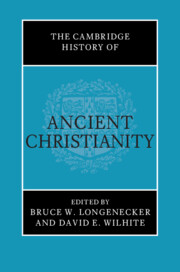Book contents
- The Cambridge History of Ancient Christianity
- The Cambridge History of Ancient Christianity
- Copyright page
- Contents
- Figures
- List of Contributors
- Editors’ Preface
- Part I Contested Contexts
- Part II Contested Figures
- Part III Contested Heritage
- 9 Jews and Christians in Pagan Antiquity
- 10 The Marcionite Option
- 11 The Gnostic Options
- 12 Early Christian Involvement in Classical Education, Literature, and Philosophy
- 13 Scriptures and Interpretations in Early Christian History
- Part IV Contested Cultures
- Part V Contested Beliefs
- Part VI Contested Bodies
- Ancient Sources
- Modern Authors
- References
11 - The Gnostic Options
Routes Back to God
from Part III - Contested Heritage
Published online by Cambridge University Press: 23 August 2023
- The Cambridge History of Ancient Christianity
- The Cambridge History of Ancient Christianity
- Copyright page
- Contents
- Figures
- List of Contributors
- Editors’ Preface
- Part I Contested Contexts
- Part II Contested Figures
- Part III Contested Heritage
- 9 Jews and Christians in Pagan Antiquity
- 10 The Marcionite Option
- 11 The Gnostic Options
- 12 Early Christian Involvement in Classical Education, Literature, and Philosophy
- 13 Scriptures and Interpretations in Early Christian History
- Part IV Contested Cultures
- Part V Contested Beliefs
- Part VI Contested Bodies
- Ancient Sources
- Modern Authors
- References
Summary
Classification systems using terminology or a symbolic system that is not intuitive form the basis of scientific “knowledge.” In this system, particularly unusual phenomena are slotted into established patterns. Then, when features that do not fit present themselves, scholars treat them in different ways: (1) scrubbing the anomalous data as individual peculiarity, or as contaminated by some outside influence; (2) engaging in fine-tuning the classification system by subdividing or changing categories or by refining the mathematical analysis; or (3) declaring the entire approach invalid. As scholars have worked to incorporate a growing corpus of Gnostic texts from third- and fourth-century Coptic codices into patristic accounts of Gnostic sects, older heresiological categories do not fit. Some scholars call for dropping the terms “Gnostic” and “Gnosticism,” but the preferred approach remains fine-tuning or revising categories.1 A common variant of “scrubbing data” in this field organizes divergent material from a text into editorial layers added to an original core.
- Type
- Chapter
- Information
- The Cambridge History of Ancient Christianity , pp. 250 - 275Publisher: Cambridge University PressPrint publication year: 2023



